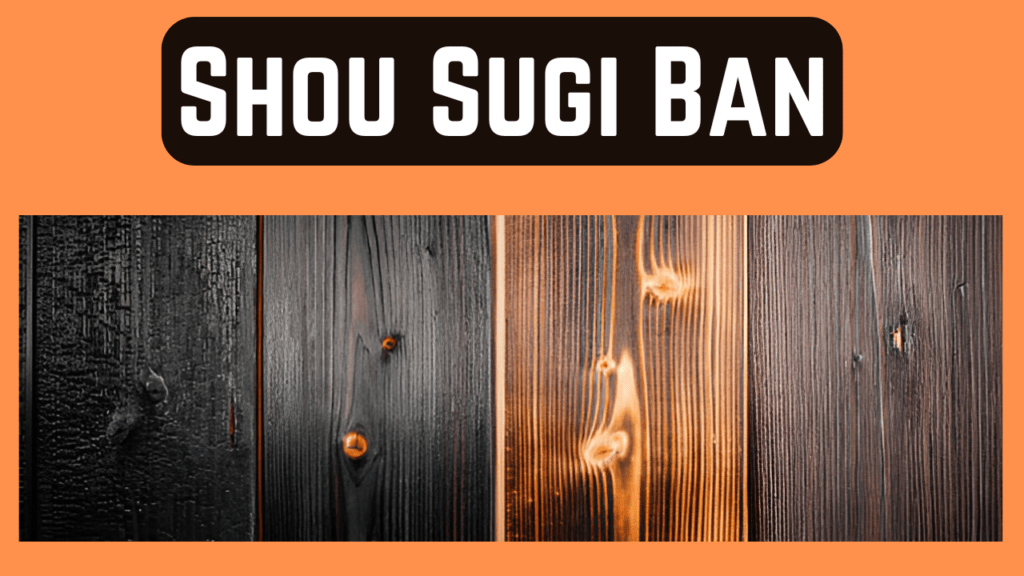
Shou Sugi Ban, which is also called Yakisugi, is an old Japanese method of burning the wood to protect it and make it look more attractive. It was first used to preserve the wooden buildings, but today it’s popular in the modern homes and buildings because of its unique look and strength.
The process involves burning the wood’s surface, creating a charred layer that gives the wood a beautiful black color and helps protect it from the weather, rot, and bugs.
This method has become increasingly popular in recent years, since it is beautiful, practical and environmentally friendly. In this post we’re going to discuss the history, how it’s done, the benefits and how is it used in Shou Sugi Ban today.
The History of Shou Sugi Ban
Origin of Shou Sugi Ban in Japan
Shou Sugi Ban originated in Japan in the 18th century. It was used at the time to treat lumber for outside walls in homes, temples and other structures. The process was developed to weatherproof wood, particularly in high-humidity and rainy environments. Its burned surface of wood made it resistant to rot, mold and insects including termites.
The Traditional Uses of Shou Sugi Ban
In old Japanese properties, Shou Sugi Ban was used primarily for siding and fencing. The method helped to preserve the wood, but also offered Japanese homes a distinctive aesthetic. In the course of time, it also got connected with plain and elegant design that is still liked in Japan.
The Influence of Shou Sugi Ban in Modern Architecture
Once a practice exclusive to traditional architecture, it has found favour over the past years globally but more so in modern architecture. Charred wood looks great and will likely to remain an in-demand material for homes, as well as commercial buildings.
Shou Sugi Ban Technique step by step
Traditional Shou Sugi Ban involves binding wood planks together into a triangular flue and lighting it internally with fire, creating an even char. Modern approaches often utilize propane torches for greater control.
After being heated up, the wood must cool before being brushed to remove loose soot revealing grain patterns and texture; once done it should then be rinsed and coated with natural oil to increase water and pest resistance and increase longevities without chemicals – an aesthetic known in Japanese culture as “Wabi-sabi,” meaning the beauty found in imperfection and ageing!
This technique produces exteriors which are naturally fireproof, insect proof, long lasting without chemicals while adhering to Japanese aesthetic of Wabi-sabi: celebrating imperfection as part of life!
Step 1: Prepare the Wood and Workspace
Select types of wood suitable for Shou Sugi Ban, traditionally Japanese cedar, but also western red cedar, cypress, pine, or basswood.
Work in a well-ventilated outdoor area with safety equipment handy, including gloves, mask, water spray, and fire extinguisher.
Elevate wood boards off the ground on concrete blocks or non-flammable surfaces to avoid fire spread.
Step 2: Burn the Wood Surface
For this step, hold a propane torch 12 to 18 inches above the wood surface. Employ it like “painting with fire”, using it to evenly char the surface until a blackened layer forms on it.
Charring intensity depends on desired texture, from light charcoaling to deep “alligator skin” cracking.
Burning continues until all wood surfaces have been charred thoroughly; orange flames may appear during deeper burns. Allow wood to cool after burning has finished.
Step 3: Brush and Clean the Char
Gently brush the charred surface with a wire brush to remove loose soot and ash but keep the textured char intact.
For heavier charring, brush more aggressively in order to reveal its unique pattern.
Clean the wood surface using water and allow it to dry thoroughly before using an air compressor to extract any residual dust or debris.
Step 4: Apply Finishing Treatments
Finish with linseed oil for a soft finish, or polyurethane sealer, which will give you an “alligator skin” type of texture and protection.
Staining is optional; it can be applied and then it can be wiped off to enhance the color and grain contrast.
Light sanding can be used across the wood grain with fine grit sandpaper (220) selectively to expose grain and make contrasts.
Keep adding on coats of finish for long term protection.
Additional Notes
Burning takes a little bit of practice to get the color to be nice and even giving it that burned look without warping or destroying the wood.
Preventative measures such as having water and fire containment devices on hand are important when torching.
The visual impression and durable surface of Shou Sugi Ban are reasons why it can form both a natural and decorative siding solution.
Tools Required for the Technique
To do Shou Sugi Ban, you will need:
- A propane torch or blowtorch
- A wire brush or steel wool
- Natural oils or wood sealants (like linseed oil or tung oil)
Safety Precautions When Performing Shou Sugi Ban
Although Shou Sugi Ban is generally safe, it’s important to follow these safety steps:
- Always wear gloves and goggles to protect yourself from the burns and flying sparks.
- Work in a well-ventilated area or outside to avoid inhaling smoke.
- Keep a fire extinguisher nearby in case of an emergency.
Shou Sugi Ban Siding
Shou Sugi Ban siding refers to the use of this charred wood technique on exterior wood panels or planks used to clad buildings. Through the process, its long-term weather resistance and low maintenance requirements make this highly weather-resistant material highly weather-resilient and low maintenance.
Its visual appeal includes anything from smooth blackened wood textures to alligator-like cracked patterns depending on burn intensity and wood species; as well as options such as deep-char finishes with some modern adaptations using species other than cedar like larch or cypress.
Shou Sugi Ban in Modern Architecture
Great for Modern Style
Shou Sugi Ban is popular in the modern buildings. It’s used on both the outside and inside of walls. The burned wood also adds the texture and stands out nicely against smooth & clean designs. This makes it perfect for eye-catching walls or building fronts.
Used Inside Homes and Buildings
Shou Sugi Ban is also used for cool-looking walls, ceilings and floors inside people’s homes. Its organic, raw appearance softens and humanizes pared-down modern spaces. It combines clean design with an organic texture.
Used Outside for Many Projects
It is also great for outdoor use. It’s often used on the outside of fancy homes, outdoor furniture, and garden decorations. Since the wood is strong and weather-proof, it works well for both useful and decorative things outside.
Different Wood Species for Shou Sugi Ban
Though it is possible to Shou Sugi Ban many woods, some types of wood are more suitable than others. Opt for the best woods such as cedar, cypress and pine with natural oils that are easier to char and have better longevity.
Best Woods for Shou Sugi Ban
Cedar: One of the more common options as it’s naturally resistant to decay and bugs.
Cypress: Durable and fragrant, cypress also responds well to the charring.
Pine: It is a common and affordable option that takes on a beautiful deep black finish when it is charred.
Shou Sugi Ban Maintenance
Shou Sugi Ban wood is low maintenance, however it can be a good idea to wipe down the surface and re-oil this kind of surface if you’re mainly using water on it. Use a mild soap solution inorder to clean the surface, and reapply a thin layer of oil every few years to keep the wood looking fresh.
Pros & Cons of Shou Sugi Ban (Yakisugi)
Pros
Durability and Long Life
Burning the wood surface actually does make it stronger. It does a great job protecting the wood from bugs, rot and weather. Which is to say, it lasts a long time and doesn’t require replacement or repair very often.
Beautiful and Eye-Catching
Shou Sugi Ban gives the wood a bold, natural look with deep textures and colors like black, brown, and gray. It compliments contemporary and traditional patterns.
Low Maintenance
Charred wood doesn’t generally need to be sealed or stained like regular wood. It will age well with time, and may even develop a soft silver color as it weather.
Eco-Friendly
This method uses fire instead of chemicals to protect the wood, which is better for the environment. It also helps the wood last longer, so we don’t need to cut down as many trees.
Fire-Resistant
The charred surface makes the wood resistant to burning. It’s not fireproof, but it does help in slow down the burning.
Unique and Cultural
Shou Sugi Ban comes from Japan and has a long history. It gives a room that special, handmade touch and a touch of natural, rustic beauty.
Cons
Hard to Find Skilled Workers
Traditional Shou Sugi Ban is a skill and experience undertaking. Not many people know how to do it well, so it is harder to find someone and more expensive to hire them.
High Starting Cost
And while it can save money in the long run, the initial cost is often high because it requires enough time and effort to do it right.
Different Looks in the Wood
Uneven textures and colors may result from the burning process. This may not be great for folks who prefer all of the wood to have the same look.
Keeping the Look Over Time
Although wood doesn’t require much care, occasional oil applications or small touchups might be needed to preserve its color and protect its durability as it ages.
Too Much Burning Can Be a Problem
Excessive or uneven burning can result in weak wood that cracks easily or breaks, which poses a threat in environments with extreme changes of weather. This issue must be taken seriously to avoid disaster.
Fire Safety Concerns
Although burning processes use fire more naturally than chemical solutions, their use must still be carefully managed in some locations where using flame is either forbidden or dangerous.
Frequently Asked Questions (FAQs)
1. What is the difference between Shou Sugi Ban and regular wood finishing ?
Shou Sugi Ban involves charring the surface of the wood, which makes it more durable and resistant to weather and pests, unlike standard wood finishing techniques.
2. How long does Shou Sugi Ban last ?
When properly maintained, it can last for decades, especially in exterior applications.
3. Can you apply Shou Sugi Ban to any type of wood?
Although you can Shou Sugi Ban can technically be applied to most types of wood, softwood ie. cedar, cypress and pine are traditionally used because of how they react to the charing process.
4. How do you clean Shou Sugi Ban?
Clean Shou Sugi Ban with a mild soap and water solution. Avoid harsh chemicals that can damage the surface.
5. Does Shou Sugi Ban require re-treatment ?
Yes, especially if you feel it may need some fresh oil or wax to keep its protection and look.
Conclusion
Shou Sugi Ban is an old and a trusted method that makes the wood both strong and beautiful. It is also a great choice for modern design—whether you use it outside on walls, inside your home, or even for the furnitures.
By learning how it works, what the benefits are, and how to care for it, you can use this special technique in your own projects with confidence.

